VOLVO XC90 TWIN ENGINE HYBRID 2017 Owners Manual
Manufacturer: VOLVO, Model Year: 2017, Model line: XC90 TWIN ENGINE HYBRID, Model: VOLVO XC90 TWIN ENGINE HYBRID 2017Pages: 584, PDF Size: 14.2 MB
Page 381 of 584

STARTING AND DRIVING
379
Auto-hold brake function
With the Auto-hold brake function, the driver canrelease the brake pedal and the brakes willremain applied, for example, when the vehiclehas stopped at a traffic light or intersection.
When the vehicle is no longer moving forward,Auto-hold applies the brakes automatically, eitherusing the normal brakes or the parking brake.The brakes will be released when the acceleratorpedal is depressed.
If the driver's door is opened or the engine isturned off, the parking brake will be applied auto-matically.
Auto-hold control
Auto-hold control and indicator light
Turn Auto-hold on or off by pressing the controlin the tunnel console. The indicator light illumi-nates when the function is on.
When Auto-hold is off, Hill Start Assist (HSA) willbe activated to help prevent the vehicle from roll-ing backwards when starting up a hill.
Instrument panel symbol
SymbolExplanation
The symbol in the instrumentpanel illuminates when this func-tion is using the normal brakes tokeep the vehicle stationary.
A
B
This symbol in the instrumentpanel illuminates when Auto-holdis using the parking brake to keepthe vehicle stationary
AUS modelsBCanadian models
Related information
•Hill Start Assist (p. 381)
•Brake functions (p. 378)
Brake assist system
The Brake Assist System (BAS) increases brak-ing force, thereby helping reduce braking dis-tance.
The system monitors the driver's braking habitsand increases braking force when necessary.Brake force can be increased up to the point atwhich the ABS system is activated. The functionis deactivated when pressure on the brake pedaldecreases.
Related information
•Brakes (p. 376)
Page 382 of 584
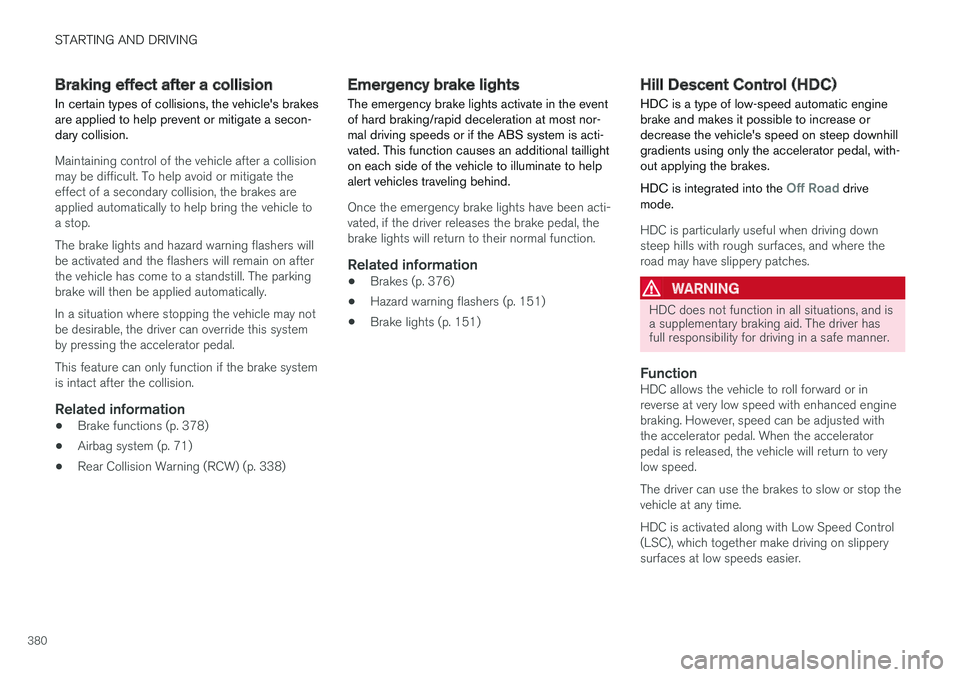
STARTING AND DRIVING
380
Braking effect after a collision
In certain types of collisions, the vehicle's brakesare applied to help prevent or mitigate a secon-dary collision.
Maintaining control of the vehicle after a collisionmay be difficult. To help avoid or mitigate theeffect of a secondary collision, the brakes areapplied automatically to help bring the vehicle toa stop.
The brake lights and hazard warning flashers willbe activated and the flashers will remain on afterthe vehicle has come to a standstill. The parkingbrake will then be applied automatically.
In a situation where stopping the vehicle may notbe desirable, the driver can override this systemby pressing the accelerator pedal.
This feature can only function if the brake systemis intact after the collision.
Related information
•Brake functions (p. 378)
•Airbag system (p. 71)
•Rear Collision Warning (RCW) (p. 338)
Emergency brake lights
The emergency brake lights activate in the eventof hard braking/rapid deceleration at most nor-mal driving speeds or if the ABS system is acti-vated. This function causes an additional taillighton each side of the vehicle to illuminate to helpalert vehicles traveling behind.
Once the emergency brake lights have been acti-vated, if the driver releases the brake pedal, thebrake lights will return to their normal function.
Related information
•Brakes (p. 376)
•Hazard warning flashers (p. 151)
•Brake lights (p. 151)
Hill Descent Control (HDC)
HDC is a type of low-speed automatic enginebrake and makes it possible to increase ordecrease the vehicle's speed on steep downhillgradients using only the accelerator pedal, with-out applying the brakes.
HDC is integrated into the Off Road drivemode.
HDC is particularly useful when driving downsteep hills with rough surfaces, and where theroad may have slippery patches.
WARNING
HDC does not function in all situations, and isa supplementary braking aid. The driver hasfull responsibility for driving in a safe manner.
Function
HDC allows the vehicle to roll forward or inreverse at very low speed with enhanced enginebraking. However, speed can be adjusted withthe accelerator pedal. When the acceleratorpedal is released, the vehicle will return to verylow speed.
The driver can use the brakes to slow or stop thevehicle at any time.
HDC is activated along with Low Speed Control(LSC), which together make driving on slipperysurfaces at low speeds easier.
Page 383 of 584

STARTING AND DRIVING
* Option/accessory, for more information, see Introduction.381
When HDC and LSC are activated, this changesthe response from the accelerator pedal andengine.
Activating HDC
This function can be activated in different ways,depending on how the vehicle is equipped.
Using the drive mode control *
Select the Off Road drive mode to activate thefunction.
Select a different drive mode to turn HDC off. Ifthis is done while the vehicle is on a steep down-grade, engine braking will decrease gradually.
From the center display's Function view
Models without the drive modecontrol have a button for HillDescent Control in the centerdisplay's Function view.
•Tap the button to activate. A light in the but-ton illuminates when the function is acti-vated.
NOTE
The function is deactivated when driving athigher speeds and must be reactivated atlower speeds if so desired.
Related information
•Brake functions (p. 378)
•Low Speed Control (LSC) (p. 428)
•Drive modes (p. 420)
Hill Start Assist
Hill Start Assist (HSA) helps prevent the vehiclefrom rolling backwards when starting up a hill. Ifyou are backing up a hill, HSA helps prevent thevehicle from rolling forward.
HSA makes it easier to start or back up on a hillby retaining pressure on the brake pedal for sev-eral seconds after the pedal has been released inorder to keep the vehicle at a standstill.
The brakes will be released after several secondsor when the driver presses the accelerator pedal.
HSA is available even if the Auto-hold brakingfunction is turned off.
Related information
•Brake functions (p. 378)
•Auto-hold brake function (p. 379)
Page 384 of 584

STARTING AND DRIVING
382
Parking brake
The electric parking brake helps to keep thevehicle stationary when it is parked.
Parking brake control in the tunnel console between thefront seats
NOTE
•A faint sound from the parking brake'selectric motor can be heard when theparking brake is being applied. Thissound can also be heard during the auto-matic function check of the parkingbrake.
•The brake pedal will move slightly whenthe electric parking brake is applied orreleased.
If the vehicle is not moving when the parkingbrake is applied, only the rear wheels are affec-
ted. If it is applied while the vehicle is moving, thenormal brakes are used on all four wheels. Thebrakes will only be applied on the rear wheelsonce the vehicle has stopped.
Related information
•Brake functions (p. 378)
•Using the parking brake (p. 382)
•Parking brake malfunctions (p. 384)
Using the parking brake
The electric parking brake helps to keep thevehicle stationary when it is parked.
Applying the parking brake
1.Put the gear selector in P.
2.Press firmly on the brake pedal.
3. Pull up the control.
> The symbol in the instrument panelflashes while the parking brake is beingapplied and glows steadily when the park-ing brake has been fully applied.
4. Release the brake pedal and ensure that thevehicle is stationary.
Page 385 of 584

STARTING AND DRIVING
}}
383
Symbol in the instrument panel
SymbolExplanation
A
B
The symbol flashes while the park-ing brake is being applied.
If the symbol flashes at any othertime, this indicates a fault. See themessage in the instrument panel.
AUS modelsBCanadian models
Automatic function
The parking brake is applied automatically:
•If the Auto Hold function is activated and thevehicle has been stationary for approx.5 minutes.
•If the gear selector is moved to P on a steephill.
•When the engine is turned off (this functioncan be selected, see "Parking brake set-tings" below).
Emergency braking
In an emergency, the parking brake can beapplied when the vehicle is moving by pressingand holding up the control. Braking will be inter-rupted when the control is released.
An audible signal will sound during this proce-dure if the vehicle is moving at higher speeds.
Releasing the parking brake
Releasing manually
1. Press firmly on the brake pedal.
2. Press the control.
> This releases the parking brake and thesymbol in the instrument panel will go out.
Releasing automatically
1. The driver must fasten his/her seat belt.
2. Start the engine.
3. Press firmly on the brake pedal.
4.Move the gear selector to D or R and pressthe accelerator pedal.
> This releases the parking brake and thesymbol in the instrument panel will go out.
NOTE
•For safety reasons, the parking brake isonly released automatically if the engineis running and the driver is wearing a seatbelt.
•The electric parking brake will bereleased immediately when the accelera-tor pedal is pressed and the gear selectoris in position D or R.
Parking on a hill
Put the gear selector in P.
•If the vehicle is pointing uphill, turn the frontwheels so that they point away from the curb.
•If the vehicle is pointing downhill, turn thefront wheels so that they point toward thecurb.
The parking brake should also be applied.
WARNING
Always apply the parking brake when parkingon hills or uneven surfaces.
Page 386 of 584
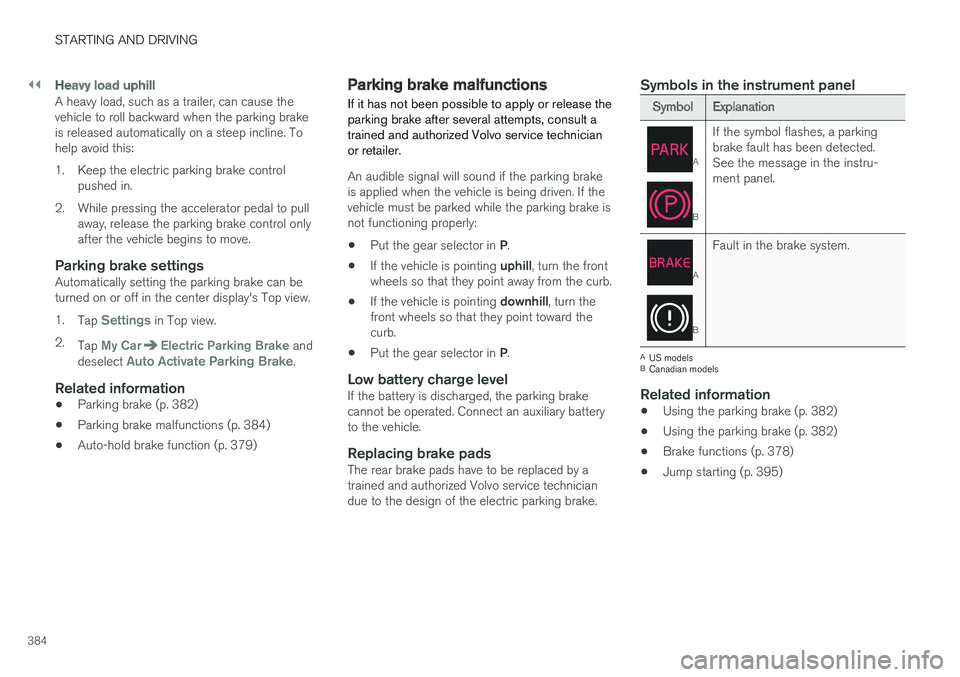
||
STARTING AND DRIVING
384
Heavy load uphill
A heavy load, such as a trailer, can cause thevehicle to roll backward when the parking brakeis released automatically on a steep incline. Tohelp avoid this:
1. Keep the electric parking brake controlpushed in.
2. While pressing the accelerator pedal to pullaway, release the parking brake control onlyafter the vehicle begins to move.
Parking brake settings
Automatically setting the parking brake can beturned on or off in the center display's Top view.
1.Tap Settings in Top view.
2.Tap My CarElectric Parking Brake anddeselect Auto Activate Parking Brake.
Related information
•Parking brake (p. 382)
•Parking brake malfunctions (p. 384)
•Auto-hold brake function (p. 379)
Parking brake malfunctions
If it has not been possible to apply or release theparking brake after several attempts, consult atrained and authorized Volvo service technicianor retailer.
An audible signal will sound if the parking brakeis applied when the vehicle is being driven. If thevehicle must be parked while the parking brake isnot functioning properly:
•Put the gear selector in P.
•If the vehicle is pointing uphill, turn the frontwheels so that they point away from the curb.
•If the vehicle is pointing downhill, turn thefront wheels so that they point toward thecurb.
•Put the gear selector in P.
Low battery charge level
If the battery is discharged, the parking brakecannot be operated. Connect an auxiliary batteryto the vehicle.
Replacing brake pads
The rear brake pads have to be replaced by atrained and authorized Volvo service techniciandue to the design of the electric parking brake.
Symbols in the instrument panel
SymbolExplanation
A
B
If the symbol flashes, a parkingbrake fault has been detected.See the message in the instru-ment panel.
A
B
Fault in the brake system.
AUS modelsBCanadian models
Related information
•Using the parking brake (p. 382)
•Using the parking brake (p. 382)
•Brake functions (p. 378)
•Jump starting (p. 395)
Page 387 of 584
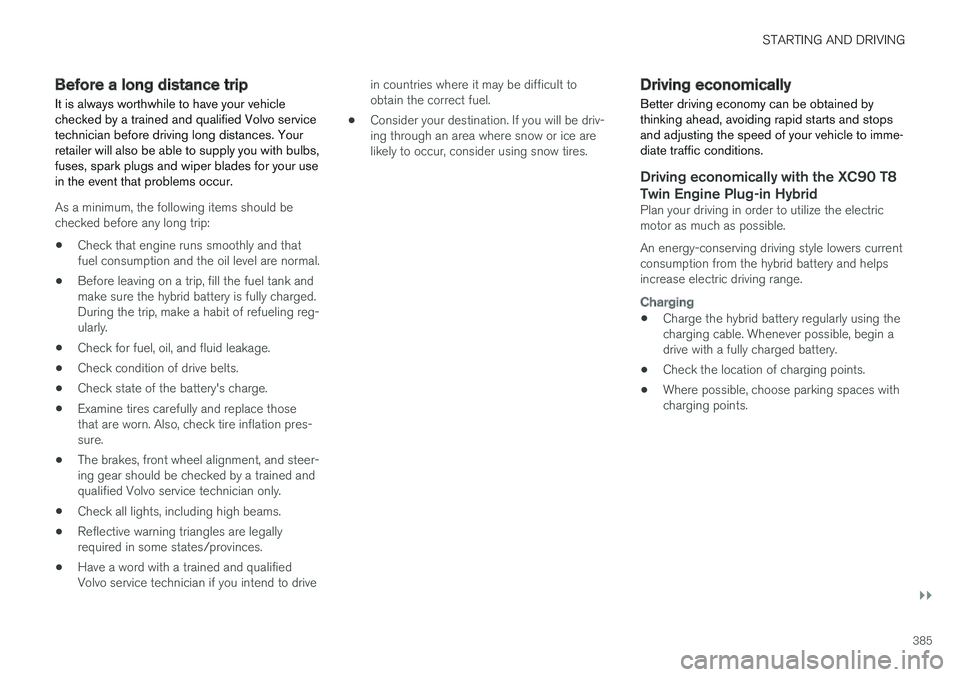
STARTING AND DRIVING
}}
385
Before a long distance trip
It is always worthwhile to have your vehiclechecked by a trained and qualified Volvo servicetechnician before driving long distances. Yourretailer will also be able to supply you with bulbs,fuses, spark plugs and wiper blades for your usein the event that problems occur.
As a minimum, the following items should bechecked before any long trip:
•Check that engine runs smoothly and thatfuel consumption and the oil level are normal.
•Before leaving on a trip, fill the fuel tank andmake sure the hybrid battery is fully charged.During the trip, make a habit of refueling reg-ularly.
•Check for fuel, oil, and fluid leakage.
•Check condition of drive belts.
•Check state of the battery's charge.
•Examine tires carefully and replace thosethat are worn. Also, check tire inflation pres-sure.
•The brakes, front wheel alignment, and steer-ing gear should be checked by a trained andqualified Volvo service technician only.
•Check all lights, including high beams.
•Reflective warning triangles are legallyrequired in some states/provinces.
•Have a word with a trained and qualifiedVolvo service technician if you intend to drive
in countries where it may be difficult toobtain the correct fuel.
•Consider your destination. If you will be driv-ing through an area where snow or ice arelikely to occur, consider using snow tires.
Driving economically
Better driving economy can be obtained bythinking ahead, avoiding rapid starts and stopsand adjusting the speed of your vehicle to imme-diate traffic conditions.
Driving economically with the XC90 T8
Twin Engine Plug-in Hybrid
Plan your driving in order to utilize the electricmotor as much as possible.
An energy-conserving driving style lowers currentconsumption from the hybrid battery and helpsincrease electric driving range.
Charging
•Charge the hybrid battery regularly using thecharging cable. Whenever possible, begin adrive with a fully charged battery.
•Check the location of charging points.
•Where possible, choose parking spaces withcharging points.
Page 388 of 584
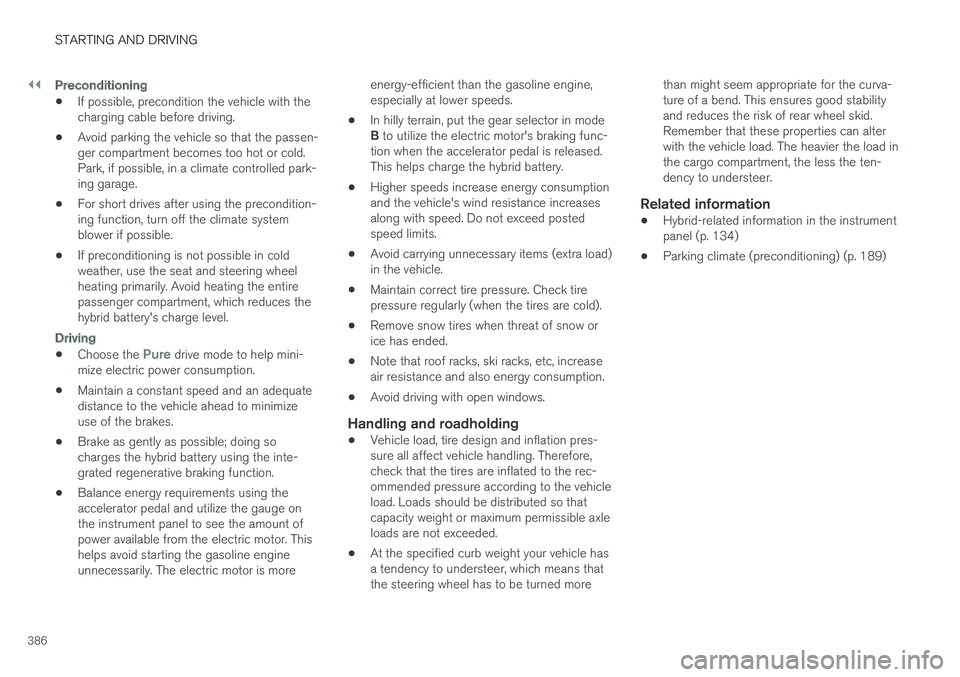
||
STARTING AND DRIVING
386
Preconditioning
•If possible, precondition the vehicle with thecharging cable before driving.
•Avoid parking the vehicle so that the passen-ger compartment becomes too hot or cold.Park, if possible, in a climate controlled park-ing garage.
•For short drives after using the precondition-ing function, turn off the climate systemblower if possible.
•If preconditioning is not possible in coldweather, use the seat and steering wheelheating primarily. Avoid heating the entirepassenger compartment, which reduces thehybrid battery's charge level.
Driving
•Choose the Pure drive mode to help mini-mize electric power consumption.
•Maintain a constant speed and an adequatedistance to the vehicle ahead to minimizeuse of the brakes.
•Brake as gently as possible; doing socharges the hybrid battery using the inte-grated regenerative braking function.
•Balance energy requirements using theaccelerator pedal and utilize the gauge onthe instrument panel to see the amount ofpower available from the electric motor. Thishelps avoid starting the gasoline engineunnecessarily. The electric motor is more
energy-efficient than the gasoline engine,especially at lower speeds.
•In hilly terrain, put the gear selector in modeB to utilize the electric motor's braking func-tion when the accelerator pedal is released.This helps charge the hybrid battery.
•Higher speeds increase energy consumptionand the vehicle's wind resistance increasesalong with speed. Do not exceed postedspeed limits.
•Avoid carrying unnecessary items (extra load)in the vehicle.
•Maintain correct tire pressure. Check tirepressure regularly (when the tires are cold).
•Remove snow tires when threat of snow orice has ended.
•Note that roof racks, ski racks, etc, increaseair resistance and also energy consumption.
•Avoid driving with open windows.
Handling and roadholding
•Vehicle load, tire design and inflation pres-sure all affect vehicle handling. Therefore,check that the tires are inflated to the rec-ommended pressure according to the vehicleload. Loads should be distributed so thatcapacity weight or maximum permissible axleloads are not exceeded.
•At the specified curb weight your vehicle hasa tendency to understeer, which means thatthe steering wheel has to be turned more
than might seem appropriate for the curva-ture of a bend. This ensures good stabilityand reduces the risk of rear wheel skid.Remember that these properties can alterwith the vehicle load. The heavier the load inthe cargo compartment, the less the ten-dency to understeer.
Related information
•Hybrid-related information in the instrumentpanel (p. 134)
•Parking climate (preconditioning) (p. 189)
Page 389 of 584
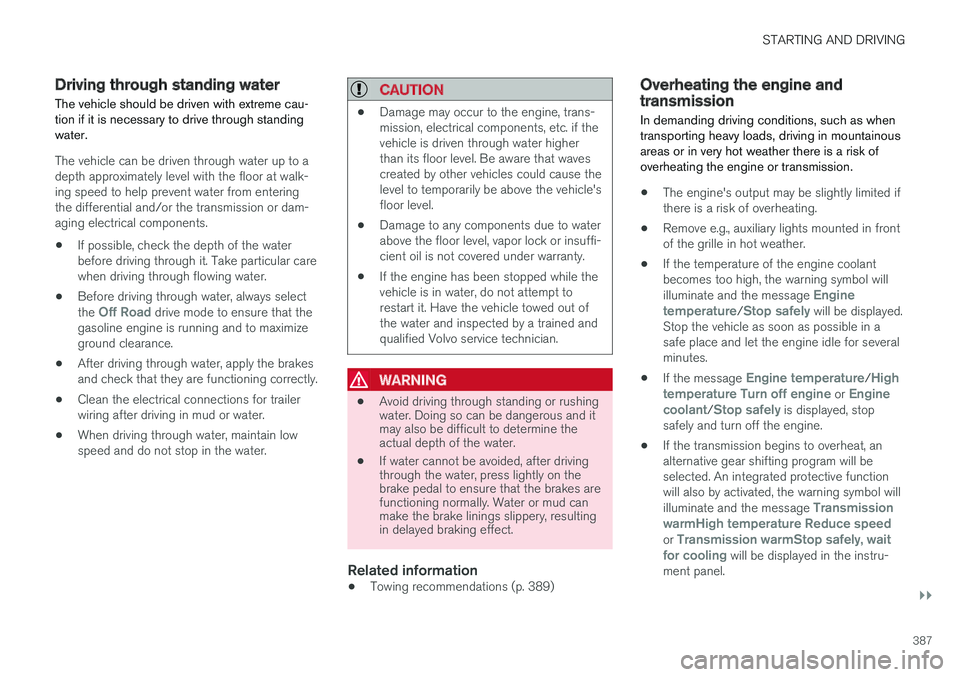
STARTING AND DRIVING
}}
387
Driving through standing water
The vehicle should be driven with extreme cau-tion if it is necessary to drive through standingwater.
The vehicle can be driven through water up to adepth approximately level with the floor at walk-ing speed to help prevent water from enteringthe differential and/or the transmission or dam-aging electrical components.
•If possible, check the depth of the waterbefore driving through it. Take particular carewhen driving through flowing water.
•Before driving through water, always selectthe Off Road drive mode to ensure that thegasoline engine is running and to maximizeground clearance.
•After driving through water, apply the brakesand check that they are functioning correctly.
•Clean the electrical connections for trailerwiring after driving in mud or water.
•When driving through water, maintain lowspeed and do not stop in the water.
CAUTION
•Damage may occur to the engine, trans-mission, electrical components, etc. if thevehicle is driven through water higherthan its floor level. Be aware that wavescreated by other vehicles could cause thelevel to temporarily be above the vehicle'sfloor level.
•Damage to any components due to waterabove the floor level, vapor lock or insuffi-cient oil is not covered under warranty.
•If the engine has been stopped while thevehicle is in water, do not attempt torestart it. Have the vehicle towed out ofthe water and inspected by a trained andqualified Volvo service technician.
WARNING
•Avoid driving through standing or rushingwater. Doing so can be dangerous and itmay also be difficult to determine theactual depth of the water.
•If water cannot be avoided, after drivingthrough the water, press lightly on thebrake pedal to ensure that the brakes arefunctioning normally. Water or mud canmake the brake linings slippery, resultingin delayed braking effect.
Related information
•Towing recommendations (p. 389)
Overheating the engine andtransmission
In demanding driving conditions, such as whentransporting heavy loads, driving in mountainousareas or in very hot weather there is a risk ofoverheating the engine or transmission.
•The engine's output may be slightly limited ifthere is a risk of overheating.
•Remove e.g., auxiliary lights mounted in frontof the grille in hot weather.
•If the temperature of the engine coolantbecomes too high, the warning symbol willilluminate and the message Enginetemperature/Stop safely will be displayed.Stop the vehicle as soon as possible in asafe place and let the engine idle for severalminutes.
•If the message Engine temperature/Hightemperature Turn off engine or Enginecoolant/Stop safely is displayed, stopsafely and turn off the engine.
•If the transmission begins to overheat, analternative gear shifting program will beselected. An integrated protective functionwill also by activated, the warning symbol willilluminate and the message TransmissionwarmHigh temperature Reduce speedor Transmission warmStop safely, waitfor cooling will be displayed in the instru-ment panel.
Page 390 of 584
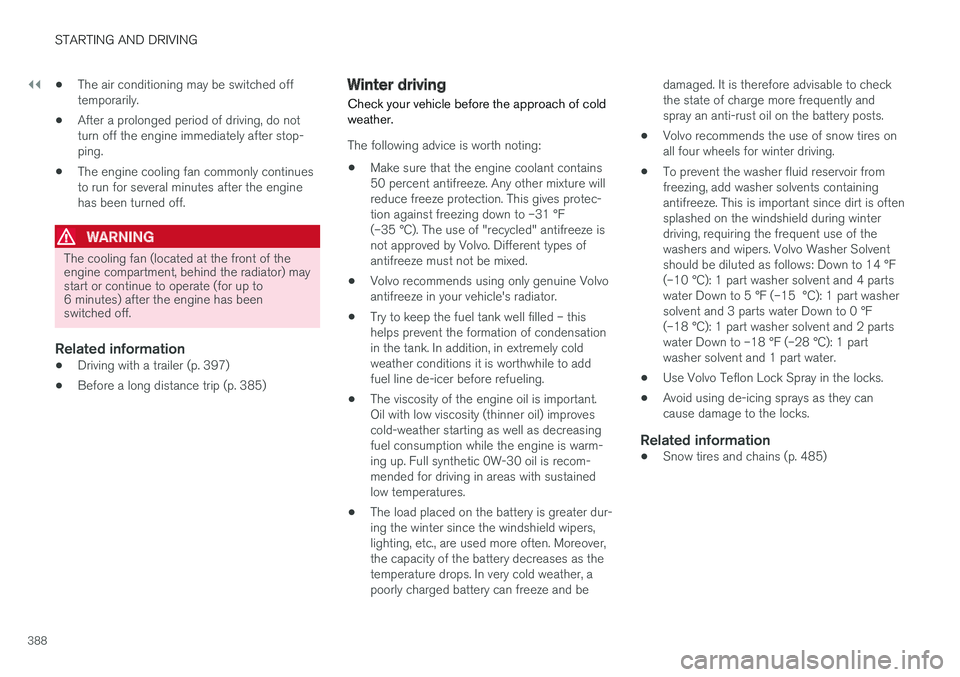
||
STARTING AND DRIVING
388
•The air conditioning may be switched offtemporarily.
•After a prolonged period of driving, do notturn off the engine immediately after stop-ping.
•The engine cooling fan commonly continuesto run for several minutes after the enginehas been turned off.
WARNING
The cooling fan (located at the front of theengine compartment, behind the radiator) maystart or continue to operate (for up to6 minutes) after the engine has beenswitched off.
Related information
•Driving with a trailer (p. 397)
•Before a long distance trip (p. 385)
Winter driving
Check your vehicle before the approach of coldweather.
The following advice is worth noting:
•Make sure that the engine coolant contains50 percent antifreeze. Any other mixture willreduce freeze protection. This gives protec-tion against freezing down to –31 °F(–35 °C). The use of "recycled" antifreeze isnot approved by Volvo. Different types ofantifreeze must not be mixed.
•Volvo recommends using only genuine Volvoantifreeze in your vehicle's radiator.
•Try to keep the fuel tank well filled – thishelps prevent the formation of condensationin the tank. In addition, in extremely coldweather conditions it is worthwhile to addfuel line de-icer before refueling.
•The viscosity of the engine oil is important.Oil with low viscosity (thinner oil) improvescold-weather starting as well as decreasingfuel consumption while the engine is warm-ing up. Full synthetic 0W-30 oil is recom-mended for driving in areas with sustainedlow temperatures.
•The load placed on the battery is greater dur-ing the winter since the windshield wipers,lighting, etc., are used more often. Moreover,the capacity of the battery decreases as thetemperature drops. In very cold weather, apoorly charged battery can freeze and be
damaged. It is therefore advisable to checkthe state of charge more frequently andspray an anti-rust oil on the battery posts.
•Volvo recommends the use of snow tires onall four wheels for winter driving.
•To prevent the washer fluid reservoir fromfreezing, add washer solvents containingantifreeze. This is important since dirt is oftensplashed on the windshield during winterdriving, requiring the frequent use of thewashers and wipers. Volvo Washer Solventshould be diluted as follows: Down to 14 °F(–10 °C): 1 part washer solvent and 4 partswater Down to 5 °F (–15 °C): 1 part washersolvent and 3 parts water Down to 0 °F(–18 °C): 1 part washer solvent and 2 partswater Down to –18 °F (–28 °C): 1 partwasher solvent and 1 part water.
•Use Volvo Teflon Lock Spray in the locks.
•Avoid using de-icing sprays as they cancause damage to the locks.
Related information
•Snow tires and chains (p. 485)